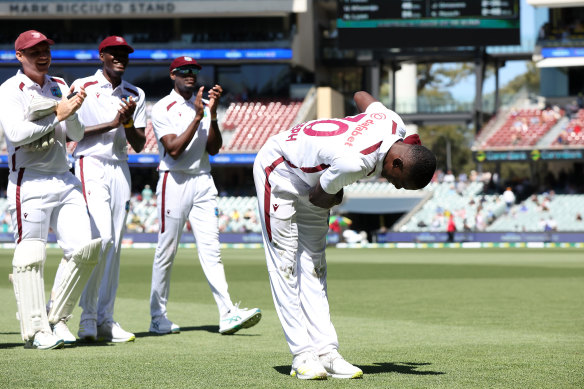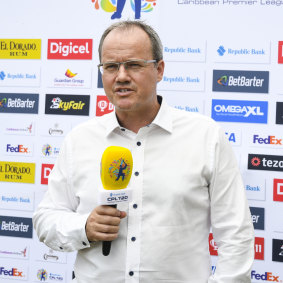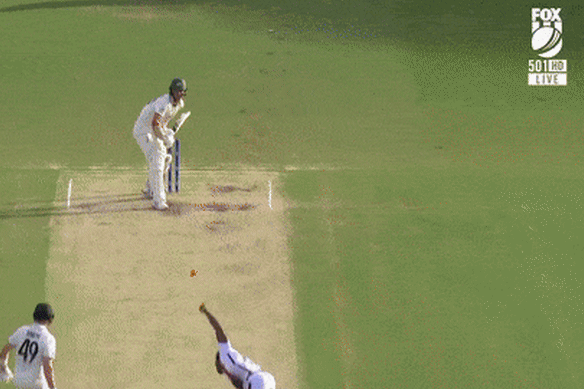This was published 1 year ago
‘Self-interest still rules’: West Indies boss challenges Australia
West Indies cricket chief Johnny Grave has challenged Australia and England to back up their rhetoric about saving Test cricket, by making structural changes that will allow Shamar Joseph’s extraordinary Gabba performance to become more like the norm rather than the exception.
In an interview with this masthead at the end of a tour where West Indies put on their best show in decades, Grave suggested bundled broadcast rights as the best way for Test cricket to thrive beyond India, England and Australia. He also shot down the contention that his region’s struggles have been purely a matter of player payments.

Shamar Joseph acknowledges the crowd in Australia during the first Test in Adelaide.Credit: Getty Images
“For me it is not very hard to get an unbelievably compelling Test match product,” Grave said. “All series being a minimum three matches with specific Test match windows would be a good start, Ashes cricket can still be five Tests, and India playing five-match series can also be accommodated.
“It’s really whether the world game can think like a league, and that for me is the biggest hurdle. Self-interest still rules. It’d be like the Premier League trying to sell Sheffield United or Luton Town home games to Sky Sports individually, versus what they get by selling all the Premier League games broadcast rights collectively and then sharing the revenue.”
It’s really whether the world game can think like a league, and that for me is the biggest hurdle. Self-interest still rules. It’d be like the Premier League trying to sell Sheffield United or Luton Town home games to Sky Sports individually.

Johnny Grave, the CEO of Cricket West Indies.Credit: Getty Images
Grave confirmed reports that the West Indies board would be eager to stage a pink ball Test against Australia in the Caribbean next summer, provided Australian broadcasters were willing to come to the party by paying a competitive rights fee for the chance to air the tour.
“Because of the way the tour is structured, it’s the first home Test series we’ve got in 2025, so depending on who plays in the World Test Championship final, and when the IPL finishes either end of May or 1st June, there’s definitely a possibility of adding a third Test,” he said.
“I don’t think we’d have to push very hard to convince Cricket Australia to come over for an extra week and play a three-match series, or our players. It’s just whether we can get an Australian broadcaster on board that really wants to do it.”
Shamar Joseph, the deliverer
In arguing for what West Indies cricket needs to gather strength after decades in the doldrums, Grave pointed to the fact that Joseph was first considered ready for international cricket via his performances for West Indies A against South Africa A – a rare development series among two of cricket’s poorer boards.
“Hopefully what it does is reinforce that we need competitive balance in our sport to create the best spectacle,” he said. “One-sided Test matches aren’t the best entertainment, and I also don’t think five-Test series have been particularly good.
“Most of them tend to be one-sided apart from maybe the last few Ashes series in the UK and because you can’t play all the Tests back-to-back, they tend to lose some momentum amongst all the other sport that’s going on when they have to take a 10-day or so break between Tests.”

Shamar Joseph wins the Gabba Test for West Indies.Credit: Fox Cricket (Fox Sports)
Grave, who has been West Indies chief executive since 2017, contends that the Caribbean’s greatest gains can be made in terms of pitches, coaching and support staff and facilities to make the most of talent like Joseph’s and help bridge the gap with the “big three”.
“If we were given extra money, we’d put it into better covers, better mowers, better rollers, better coaches, physios, strength and conditioning at lower levels,” he said. “Indoor facilities, more bowling machines, these kinds of things. Not just pay our players more money.”
Grave pointed to the example of Glenn Maxwell, a white ball legend for Australia but only an occasional Test player, as an example of the sort of multi-dimensional approach that the West Indian selectors were now taking.
Collectivism and Test cricket
Living about three hours’ flight away from mainland USA gives Grave and West Indies cricket a close view of how collective selling of broadcast and commercial rights has created a hyper-competitive sporting marketplace.
In Britain, where Grave worked before joining West Indies cricket, Premier League broadcast rights are also sold collectively rather than broken up on a team-by-team basis. The resulting share of revenue hasn’t meant that the big clubs have become small, rather that no team can dominate easily.
Grave’s blueprint would feature minimum three-Test series, giving the World Test Championship a bigger prize purse than the World Cup, a Test match fund to balance out logistical costs and player match fees, and collective bundling of overseas rights - an idea previously discussed by CA in 2016.

The NFL’s broadcast revenue model is an example of collectivism in sport.Credit: Getty Images
“Collective selling of broadcast rights, even if it wasn’t in home markets,” he said. “So Australia can still sell their home rights to the Australian broadcasters and retain most of that money, but all the overseas rights are pooled together and sold as a larger package of all Test or even all international bilateral cricket.
“Then a fairer share of those revenues is provided to all the teams who are participating to ensure better competitive balance and sporting jeopardy.”
Tiny steps as opposed to big leaps
March is set down for the next round of International Cricket Council meetings.
CA’s chair Mike Baird has stressed the need to put international cricket’s health at the top of the agenda. But a recent report out of India suggested that a more likely change will be that the role of ICC chair, currently occupied by New Zealand’s Greg Barclay, will have its terms extended from two to three years, just in time for India’s Jay Shah to have his turn.
Grave remains optimistic that the memory of Joseph’s feat, plus the commercial pressures of looming broadcast rights deals in both India and England after CA’s was signed last year, will force some fresh thinking.
“I think if we really challenge ourselves about how we can make Test cricket a bit more fan friendly we’d have series and dates and venues confirmed years in advance,” he said. “We’d put significant marketing budgets behind it, via maybe a central digital marketing budget to ensure fans know when and where matches will be played and which channels they can watch on, then it would have a big impact.
“All the T20 leagues get huge marketing budgets behind them but Test cricket gets none outside of perhaps Ashes series. With Test match windows and say four nations playing four nations, so you’ve got four compelling Test matches across the time zones all at the same time, the whole game comes together to promote and celebrate Test cricket with all the storytelling from the past and the format and everything else.
“If you can do that, I really think the game can thrive and grow rather than meandering along and every now and again the format and the player performances give the game a massive boost. I just feel it could and should be so much more.”
In both Australia and England, Test cricket is still the bulwark of the two boards’ broadcast deals, and if anything are growing more important as bilateral white ball games lose their lustre.
“That’s why the Gabba is so important,” Grave said. “If you think about the most memorable moments in Test cricket over the past 10 years, everyone can remember them, they make front page news, and T20 cricket doesn’t do that at franchise or even international levels.”
News, results and expert analysis from the weekend of sport sent every Monday. Sign up for our Sport newsletter.